Browse my new Nature & Gardening Books page for listings of books I've found helpful in my woodland project. There are some great books on gardening with native plants, plus field guides to wildflowers and trees.
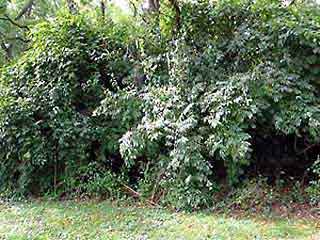
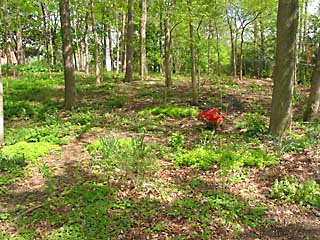 |
Welcome to my quarter-acre woods
Going on the fifth year of my woodland project. Toothwort, Virginia bluebell, mayapple, wild geranium, waterleafsand ramps are flourishing, along with many more bloodroot and Dutchman's breeches, spring beauty, wild columbines and a few Solomon's seal. The honeysuckle and garlic-mustard wars are virtually won, but you can never take that for granted. I still find one or two sprouts of one or the other every time I walk through the woods. They hide under bluebells and geraniums and cower at the base of trees. I wasn't able to do much in the woods last year, along with baby-sitting and finishing my new book, which is coming out in July, 2006, but I did manage to keep up the battle against the invasive plants. Here are a few photos to update the project. The top photo at left shows how the woods looked at the start of the project in 2002. Beneath that, the view in 2004.
|
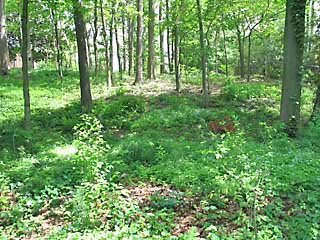 |
At the beginning of the project the only green you could see on this hill was a mass of garlic-mustard that hadn't been cleared yet. Now there are several groundcovers, including sweet woodruff, bugleweed, blue violets and waterleaf. I know I need to watch the groundcovers so they don't wipe out the spring ephemerals, but they are all low-growing and not tall and rank like the mustard and honeysuckle. Compare this recent picture to the 2004 view above.
|
 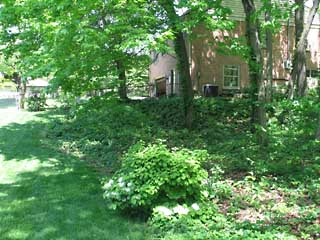
|
The bank was completely cloaked in honeysuckle bushes over ten feet tall, which were cut down on this slope in 2002 (left). We planted a stand of eight little dry-root redbud trees here in 2002. They have all survived, with the ones at the top of the slope being slightly bigger. We actually had a few blossoms on one of the trees this year, which thrilled me no end. There are other plants and shrubs growing on the hill now (below left): a drift of sweet woodruff groundcover interspersed with blue violets and a few mayapples. At the bottom of the slope is a lovely dogwood that started to bloom this year, too. To the right there is a little stand of wildflowers, including bloodroot, Dutchman's breeches, spring beauty, black cohosh, yellow corydalis and more. In the foreground is a viburnum. This area gets some water during the dry season. We had our lawn sprinklers reset to irrigate this part of the lower woods.
|
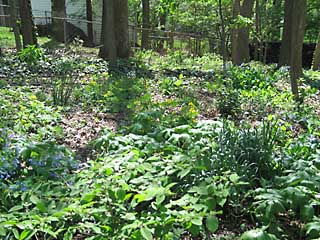 |
Here and there in the woods I transplanted a few bluebells from the spread near the patio. They are self-seeding and beginning to grow in areas that have been bare, except for the garlic-mustard. I loved seeing the blue throughout the woods this spring, contrasted with the beautiful yellow of celandine poppies that bloom at the same time. Now the bluebells are subsiding. Wild geraniums and mayapples are flourishing in areas where I haven't seen them in for years. Sweet cicely just started to bloom today.
|
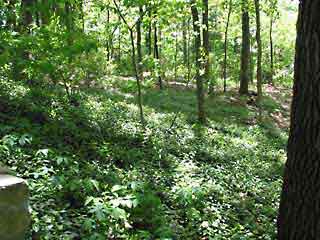 |
This area hasn't changed much. There is a large area of groundcover that includes native Virginia creeper. There used to be a small grassy patch here that was hard to mow and didn't do well in the shade. I started some periwinkle and euonymous and they seemed to disappear under the honeysuckle. I had no idea they were flourishing until we took the honeysuckle out. There are now some bloodroot in this area and lots of toothwort, a few geraniums and sweet cicely.
|
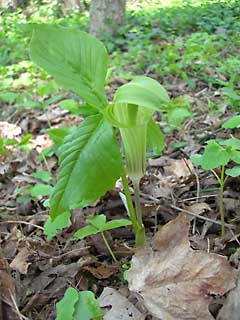 |
My little Jack-in-the-pulpit is a seedling from one of the two plants that grow in the upper woods and my shade garden. I originally bought one plant at the arboretum many years ago and put it about ten feet from the patio. It never bloomed and some years didn't come up at all. Then our dogs both died and the next year, up pops the Jack. It was directly on the path the dogs had worn into the woods and the poor thing had been trampled year after year. It became very robust, so I took a piece of it and transplanted it to the shade garden. I've been planting the seeds from these plants for a couple of years and this is the first to flower. |
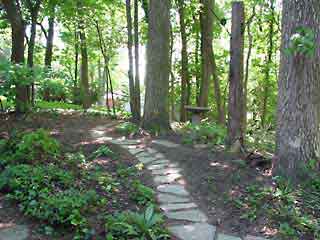 |
At the top of the woods I laid a stone path from the patio into the woods. Where the stones stop, the path begins. It's a very inviting entrance to the woods. My little granddaughter likes to go into the woods along the stone path. The first year I mulched the path, but I decided it looked too unnatural. Now I outline the path on both sides with fallen branches. I let the wildflowers seed themselves on the path and walk around them, but I generally just walk over the groundcover.
|
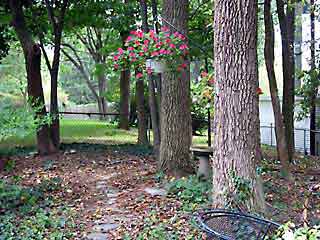 |
The kitchen window overlooks this path into the woods. I've planted shooting star, Lenten rose and columbine plants beside the path and they all bloom beautifully. A hook attached to a tall tree stump held this hanging basket or a bird feeder and to the right was a squirrel feeder. Unfortunately, the stump rotted out early this spring and it fell over. I haven't decided what will replace it. This is a very busy place in the fall and winter months. There's a lot of wildlife in this small woods.
|
|
|
|
|
|
|
Wildflowers |
Home Return to Top
|
|









